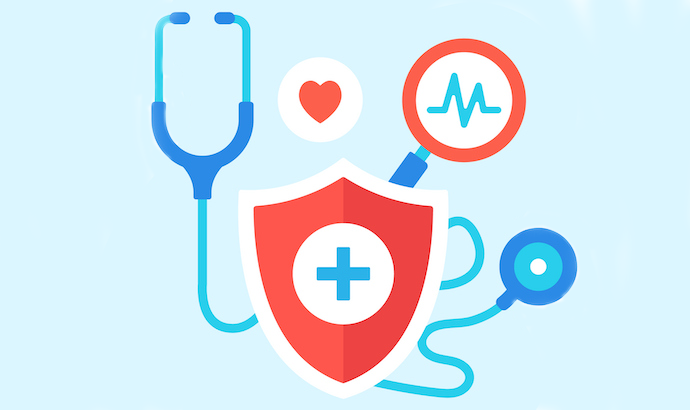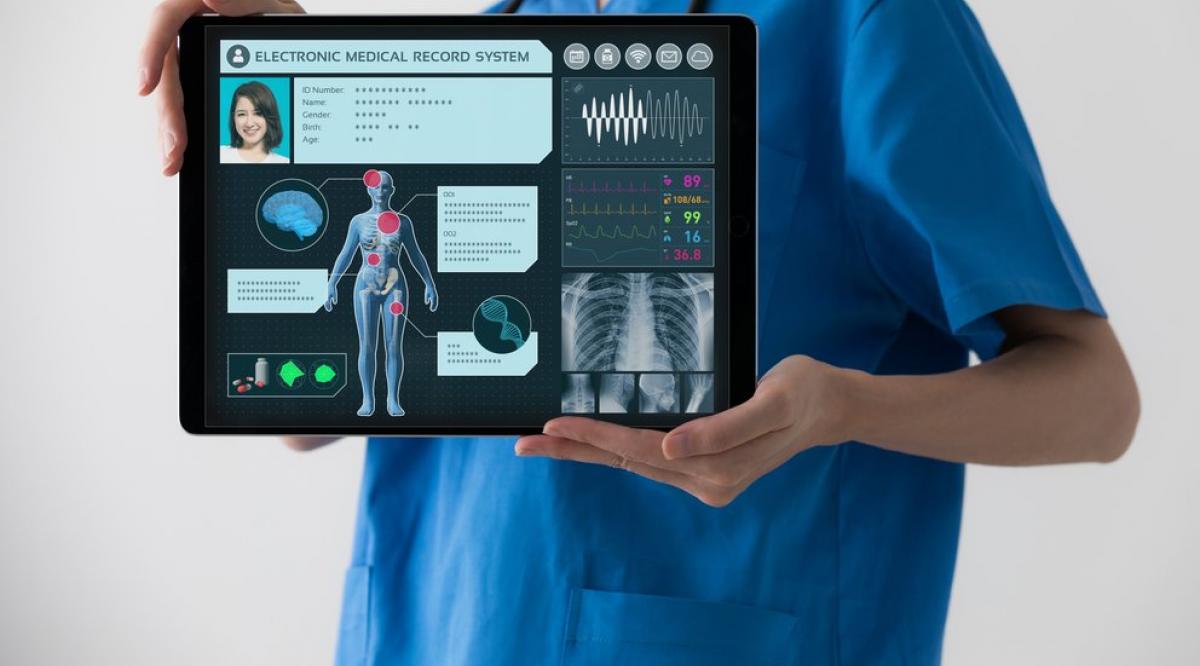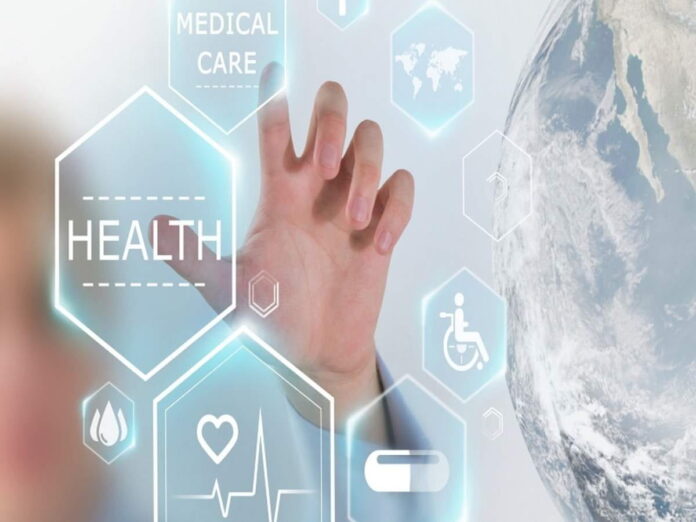The Covid-19 pandemic caused a disruption in the whole world from multiple dimensions, starting with health till economic and social impacts on every society.
It seems that we are going to co-exist with the Covid age for some years, which would urge humanity to respond and adapt to the new lifestyle.
Covid-19 pandemic is going to change the future in multiple aspects, and the biggest one is in healthcare and the whole medical industry.
We might live in a different state of new measures and tools that would achieve success against beating diseases and death due to pandemic situations.
Healthcare Technology Heralds a Healthier World in the Future

The bright spots include the unprecedented acceleration of innovation, collaboration, and discovery, a catalyst for a future of health and medicine that can help us reimagine and bring us a healthier, smarter, and fairer post-Covid world.
Now, many solutions are riding the train of rapidly advancing technologies that are rapidly multiplying in their performance, as evidenced by Moore’s Law, which has enabled billion-fold improvements in memory and computing performance, leading to the proliferation of super-processor smartphones that most of us carry in our pockets.
I still have my old smartphone here. It still works, which seemed magical 12 years ago but now seems sluggish and weak.
I’m sure my new smartphone will soon look antiquated, perhaps when its features fade away with the soon-to-be-arrived smart augmented reality glasses.
Now the exponential technologies packed into our smart devices are increasingly medical, with sensors capable of detecting ear infections and more.
What used to fit a desktop computer now fits our wrist, and these are now entering the field of FDA-approved medical devices.
But the future is not dependent on any one technology, but rather on its convergence, as it becomes faster, cheaper, and better.
Indeed, the future is all about creating whole new fields on its fore, from computational biology, robotic surgery, digital therapies, and telemedicine, to AI-based radiology.
While many industries have disrupted and penetrated into the Fourth Industrial Age, the health and medical industry often seem stuck in the second or third.
Important data is still stuck and is shared on fax machines and paper forms.
We are stuck in waiting rooms waiting for our visits.
I recently had my own MRI which was only made available to share with me on CD. I don’t even have a CD player anymore.
The tools for managing pandemics in 2020 rely on the same basic technologies used in the 1918 pandemic: face masks, social distancing, and hand washing; So part of the challenge in advancing global and local health is our models and mindsets.
We don’t really do healthcare, we do sick care.
Pathological care is based on discrete episodic data, usually only obtained within the four walls of a clinic or on a hospital bed, and leads to our reactive model of patient care, where we wait for a patient to appear in the emergency room with a heart attack, stroke or stage cancer late or the arrival of the epidemic on our shores.
I believe that the convergence of the many accelerated technologies and approaches being catalyzed by Covid will move us from intermittent patient care to an era of continuous, proactive, personalized, and collective contribution-based healthcare that can increasingly deliver care anytime, anywhere, more effectively, and at lower costs around the planet.
For example, the convergence of smaller interconnected devices currently running on the 5G network is creating not only the Internet of Things but the Internet of Medical Things (IOMT).
Much of this convergence in digital health depends on the ability to connect the dots between data sources from personal genomics and medical records to applications and services that match the needs of the individual, whether patient or caregiver.
As incentives and compensation align, Covid has pushed us to increasingly virtual healthcare, from the hospital to the home, to our phone, up and into our bodies. The hospital at home era will bring the hospital to you wherever you are.
Today, the challenge of this hyper-connected era is that we create massive amounts of big data in healthcare that are often isolated in formats that can’t even talk to each other and lacks interoperability.
So we need to narrow that gap between data, turn it into meaningful information to patients, physicians, and public health workers, and accelerate its safe and effective use in the community clinic and at the bedside.
The pandemic has spurred a massive amount of international engagement and cooperation between clinicians and researchers to narrow this gap.
What was learned in managing patients in Wuhan and then in intensive care units in Italy helped hospitals in New York and Riyadh and in turn spread their learning to centers around the world.
Major Changes Happened Because of COVID-19 in Healthcare Paradigms
Let’s take a quick look at some examples of what’s happening across the healthcare paradigm in the age of COVID and the implications for the future.
From new forms of data to help predict prevention to faster diagnoses, to more personalized treatment and increasingly collaborative discovery.
The Most Important Developments in the Field of Prevention

Now, while our genome influences our health outcomes and health, it is our social determinants of health (our social and everyday behaviors) that drive most of our disease risks and associated costs.
And we now have a huge increase in new tools to help measure and improve our health behaviors. The first Fitbit was launched in 2009.
Wearable devices are becoming ubiquitous and can measure nearly every component of our physiology, behavior, and even our mental health.
They are evolving all the time from a disposable tattoo that can stream vital signs 24/7, to big data integration that can – even small data from a simple wearable device – track a patient who goes home after a hip replacement or injury.
Coronavirus and can determine whether the patient is recovering as expected, or walking more and whether he is in the best condition or not, and prompts rapid intervention.
We are evolving from a world of self-identification where our digital data remains silent on our devices to a kind of quantifiable healthcare, where data can be safely shared with clinical teams and researchers to help improve prevention and early disease diagnosis, through feedback loops and personalize and improve treatment.
From the vital components of a wristband, including blood pressure, which can now be obtained without a bracelet, and soon sensors that will measure blood oxygen levels to continuous blood glucose monitoring, to trauma devices, onebridge hearing aids, and rings that could replace a sleep laboratory.
Completely fitting our finger into internal devices, microchips under our skin, to track our physiological and laboratory values, even wearable devices under clothing, a network of medical sensors is very cheap today.
You get a pack of ten, you have one on each pair of your underwear, now used to do what’s called remote patient monitoring, in order to help detect signs of respiratory decompensation for patients with bronchitis or Covid.
Respirators also bode well; Nanosensors can detect molecules in our breath that are linked to cancer, metabolic diseases, and even infectious disease diagnosis.
Invisible ambient sensing from cameras based on artificial intelligence can track our vital signals, to express as a biomarker to manage and detect mental health challenges, and signs of heart disease, and now has the ability to distinguish coughs from colds to coughs caused by the Coronavirus.
And we’ll soon be blowing out our 24/7 digital exhaust, our digital book. How do we understand it and really benefit from it?
One Way: Through crowdsourcing. The All of Us trial, which includes 1 million participants from the National Institutes of Health in America, does just that.
Where data donors can contribute our medical records, genomes and wearable data to build the best diverse data set, beyond racial and socioeconomic groups to help advance precision medicine that is better for us all.
Incorporating this information for the individual and public health will result in predictive policies similar to our personal check engine lights, which can give us anticipatory early warning.
Recent research shows that wearable devices can pre-dete the onset of influenza, or as recently published by Stanford University, in more than 80% of Covid patients.
Smartwatches can detect Covid infection early, often days before symptoms appear.
Self-reporting sites such as Covid Near You or our social distancing app may offer us the ability to create injury maps locally, along with social graphs and contact tracing apps, and provide detailed suggestions on who we might want to consider near or far. socially.
Development and Future in Medical Screening and Remote Monitoring

What used to require an entire clinic or lab can now fit in a digital doctor’s bag or patient’s pocket.
We’re starting to integrate Covid quarantine kits that allow tracking of oxygen saturation, temperature and lung sound into virtual visits; This provides real-time improvements to a virtual physical examination.
Diagnostic tools are becoming increasingly saturated with machine learning, an artificial intelligence technique, including consumer ultrasound, that can provide diagnoses anywhere at very low cost, including the ability to assess lungs in suspected Covid patients.
The lab has shrunk to microfluidic platforms that can be connected to our smartphones and enable anyone to take measurements from blood or saliva.
Many of these diagnoses make use of a smartphone and its camera to obtain a medical selfie.
For example, instead of taking your urine to a lab to diagnose a possible urinary tract infection, inside your home simply dip a urine dipstick, take a picture with your smartphone camera, and make the results immediately available to your doctor and pharmacy.
Similar phone-based applications and approaches are being used and developed for rapid, frequent, cheap and easy COVID testing.
New approaches to community-level diagnostics are also being explored, including genome sequencing of wastewater for early detection of COVID-19, identification of hotspots and projected outbreak a week or more in advance.
However, the vast amount of data sources truly exceed the ability of the human brain to integrate effectively. We are now getting help from artificial intelligence.
AI is being used to read CT scans to diagnose Covid and to enhance the view of the gastroenterologist performing colonoscopy to identify lesions they may have missed.
AI plays an active role in helping to identify and develop new antivirals.
And while AI is seen by some clinicians as a threat, it cannot replace human touch or empathy.
I don’t think doctors or nurses will be replaced by AI, but doctors and healthcare systems that collaborate with AI in the future will replace those who don’t.
Developments and the Future in the Digital Therapeutics

The pandemic has significantly sped up the use of virtual visits. Telemedicine visits have increased by 1,000% in many places.
And I don’t think we’ll ever go back to pre-Covid levels where patients and doctors discover convincing relief and efficacy.
Even before the virtual Zoom or Facetime apps were used with the doctor, asynchronous screening and support were provided by smarter chatbots, which could help differentiate symptoms and triage problems effectively and at a lower cost.
This includes virtualization and virtual reinforcement to address the mental health crisis, which has been exacerbated by the many economic and other stresses that accompany this pandemic.
3D printing is also finding an impactful role in healthcare, with newly discovered applications from printing personal masks to critical parts of respirators and taking advantage of the growing manufacturer movement, which is playing a key role in responding to the pandemic, from making protective coverings and face masks to manufacturing ventilator spare parts or even inventing new ones for your personal use.
Together, these efforts offer the potential to democratize health and medicine across the planet and access previously inaccessible information and care.
Clinical trials are being reshaped, leveraging smart devices, cloud analytics platforms, and collaborators around the world.
With this convergence of so many rapidly evolving technologies, we have the true potential to reshape and extend healthcare in our pandemic age.
Where we can dramatically expand access to essential healthcare, increase personalization and proactiveness, leverage the scale of digital platforms and technologies, advance digital communication and empathy, be able to blend virtual and in-person care, and harness the power of the crowd to share and build better maps that guide our personal and public health journeys, and to develop solutions that have been validated and scaled.
So; Imagine a new generation of volunteers, a global health body similar to today’s volunteer paramedics and firefighters whose skills can be sharpened, using powerful new tools to respond early and collectively to enhance contact tracing, isolation, and quarantine, to help identify and address social disparities and more.
Our Role in This Change
If we work together as one person to tackle this epidemic, Just as the establishment of our country, brought together men and women to work creatively and collectively to build our dear country, so this can lead in our pandemic era to a period in which we achieve our greatest ambitions and achieve a real healthy era.
I believe this is possible if we all step out of our linear way of thinking, take exponential steps and cooperate collectively, not only solving the challenges of this pandemic and predicting the future of health and medicine but boldly moving forward together to accelerate the process of making life much better for everyone on this earth.

